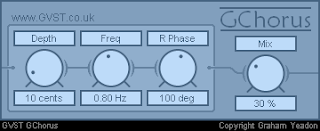Hello and welcome to This week's article!
Today we're going to talk about Modulation Effects, focusing on the Chorus Effect.
Modulation effects are filters that takes a given signal and creates a copy, with a given delay and pitch modification, to be summed with the original one, creating a wide range of different results.
The Chorus effect is an effect that can enrich remarkably a sound: it doubles the sound creating a slighly delayed (usually around 20ms) copy whose delay will not be stable but will keep on variating, oscillating 5ms more and less, plus the copy's pitch is slighly detuned, giving the impression that the copy is (in case of a Vocal track) another person singing along with the first one: not identical, but very similiar, and this effect is used to make the original sound wider and fatter.
This effect was particularly used in the mid '80s, for Vocals and guitar solos, in order to add more character and make them sound more metallic.
The Chorus' most common controls are:
Depth: This control sets the depth of the effect: the higher the value is, the deeper will be the oscillations. Basically it's the Chorus' intensity.
Rate: This one sets the effect cycle, which is the speed of the Rhythmic detunings, from very slow (less than a cycle per second), if we set it to 0, to very fast (rarely used), if we crack up the control.
Feedback: This control refers to the process of feeding back a part of the effected sound on the input of the effect itself, therefore we decide how much chorus will be sent a second time through the effecting process: this will lead to a much more effected result, good for creative uses.
Level: This one sets the mixing level of the Chorus with the original sound: a higher value will lead to a higher wet-to-dry ratio.
Most of DAWs already features a Chorus effect, but if you want to try some cool vst downloadable for free here's our suggestions:
OrangeChorus: one of the best free Chorus Vst Around, very simple.
Blue Cat Chorus: versatile Chorus with Spread control
Kjaerhus Classic Chorus: a simple but effective chorus
Gvst Chorus: simple and effective chorus Vst
Tal-Chorus-Lx: an interesting vintage chorus modeled after the Roland Juno 60
Betabugs Monsta Chorus: an interesting vintage chorus effect
Chorus Ch-2: a versatile Hi Quality modulation engine
SimpliChorus: an interesting Stereo Chorus effect
Most of DAWs already features a Chorus effect, but if you want to try some cool vst downloadable for free here's our suggestions:
OrangeChorus: one of the best free Chorus Vst Around, very simple.
Blue Cat Chorus: versatile Chorus with Spread control
Kjaerhus Classic Chorus: a simple but effective chorus
Gvst Chorus: simple and effective chorus Vst
Tal-Chorus-Lx: an interesting vintage chorus modeled after the Roland Juno 60
Betabugs Monsta Chorus: an interesting vintage chorus effect
Chorus Ch-2: a versatile Hi Quality modulation engine
SimpliChorus: an interesting Stereo Chorus effect


No comments:
Post a Comment